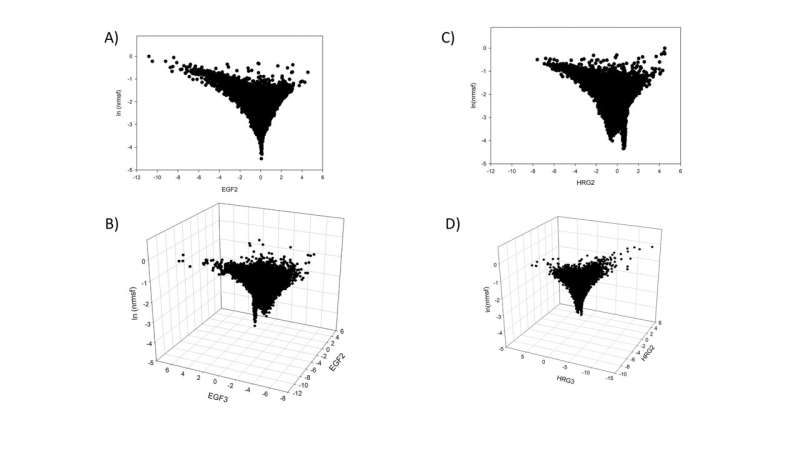The "motion" properties of the single genes (points in the figures) at both 3D and 2D representations. The presence of very "highly variant" genes in both the motion components (HRG2, HRG3) is the signature of an effective phase transition ending up in cell differentiation. Credit: Alessandro Guiliani
At more than 2 meters long, the human DNA molecule uses intricate folding patterns to fit into cells while locally unfolding to express genes. Such phenomena, however, are difficult to measure in experiments, and theoretical frameworks explaining them continue to be at odds with one another.
Researchers in Italy, Japan, and Poland seek to point a way toward a unified theory for how DNA changes shape when expressing genes. Presenting their work in Biophysics Reviews, the scientists use an approach called statistical mechanics to explore the phenomenon of so-called expression waves of gene regulation.
The group hopes to reconcile a long-standing gulf between the two scientific fields most involved in the topic.
"Many scholars at the crossroad between physics and biology are now approaching what is probably the most crucial puzzle of biology," said co-author Alessandro Giuliani. "How is it possible that, starting from the same genetic background in the fertilized egg, around 400 highly differentiated cell types can arise, each endowed with a specific physiological role?"
Biology-based theories often center on regulator proteins, called transcription factors, that biochemically conduct a symphony of genes to be expressed together. By contrast, many physicists have focused on expression waves, the rhythmic changes in expression levels across the genome, driven by relaxation and condensing of the DNA molecule itself.
"It is something like the so-called hola, common in soccer and in other sport events, in which the spectators stand up simultaneously giving rise to a 'wave' spreading all over the stadium," Giuliani said.
To get at the heart of the issue, the group focuses on a specific type of cell found in breast cancer with a proven track record of consistently behaving the same way to stimuli.
They used statistical mechanics to make sense of how DNA molecules fold by assessing the collective behavior of a huge number of microscopic players in terms of ensemble properties, unlike classical top-down perspectives, like Newton's laws.
Ultimately, the researchers landed in favor of expression waves, acknowledging that while transcription factors play a vital role, they are second fiddle to the changing shape of DNA.
To unify these two perspectives, the authors present their conclusion using concepts common to biology and physics, limiting the use of mathematics to intuitive approaches such as recurrence quantification analysis and the classical statistical method of principal component analysis.
Next, they look to apply the same approach to identify ecological tipping points based on the makeup of species in particular habitats.
More information: "Self-organization of whole gene expression through coordinated chromatin structural transition" Biophysics Review, 2021. aip.scitation.org/doi/full/10.1063/5.0058511
Provided by American Institute of Physics
























